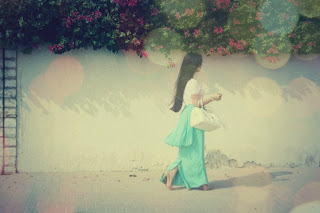 |
Beautiful and stylish, Omani fashion blogger, Shurooq Al Haremi demonstrating that to be modest is not always boring and certainly not unattractive. She is wearing an outfit here, that my own in-laws would probably be okay with allowing a guest to wear into their homes (albeit they'd prefer some semblance of a scarf on the head however little it covers). Her blog: http://hershoolathots.blogspot.com/ |
I will give you an example of my own "more country" Omani inlaws. In a house that has more than one family living together, women in the house wear floor length long sleeved loose floral printed gowns with matching shawls on head (not necessarily but almost always covering every single strand of hair and the neck). Most men see only their closest inlaws like this. Outside the home black abayas are worn on top of these dresses and ankles aren't seen as women wear tight pants underneath their skirts and dresses. So yeah, men who are from here and haven't travelled will invariably find ankles sexy and tight fitting clothes.
When I became a Muslim in the West I adapted many Muslim peices of clothing to my culture. I usually didn't wear the black veil. I wore coloured ones with big pretty flower broaches/pins attached to it so that Westerners wouldn't find my ultra conservative mode of dress as scary. Usually the colour of the veil started a conversation. "Muslim women are allowed to wear colours?" Yes, of course we are. We often choose not to, or culture insists we don't but the religion totally promotes colours. I also wore abayas, but more stylishly cut and embellished ones than you are likely to find in a remote interior Omani village.
 |
Zubaida Jacobs, a Dubai-based fashion blogger, wearing an outfit totally cute and modest enough for Muscat even with a fitted waist and more fitted t-shirt top. Not what my inlaws prefer but nothing out of the ordinary for the capital. Her blog: http://www.butterhotshoes.com/ |
1.) The difference is absolutley huge in what impact one can get from the culture. For example, a famous Lebanese TV host visited our village in a mini skirt and tank top to interview the head of the village. He out and out walked away and ignored her. Which might make Omanis come across as rude.
2.) A pair of South African girls in attempts at modest dress {skirt blowing up, pants and t-shirt too tight} came to our village and none of the women from the village offered to give them a tour and everyone even the men hid from their camera lenses. Which might make it seem that Omani women and men are secretive unsocial creatures.
3.) Two women, both Swedish journalists, came to do a story on our village for the Eid. They wore loose trousers with loose knee length tunics on top and fitted long sleeve pajama t-shirts poking out. Very "the English Patient" chic still. They draped scarves loosely (not tied) over their hair. We could still se emost of their hair but my own mother-in-law took it as a sign of respect and the women of the family invited them to join in on the festivities in our house. A limited number of photos were permitted to be taken of the women (albeit only detail shots not of faces).
4.) A Japanese non-Muslim tourist dressed head-to-toe in black abaya and black head scarf came to tour the village. Every single woman came to greet her, invite her to their homes for food and visiting, and alot fo women allowed her to take their full-body face-shot included photographs.
As you might note, the experiences people had of the Interior of Oman where my in-laws are from can totally change depending on how they dressed and where they go (off the road from more tourist-ridden cities like Nizwa ect;)). I want to end this post by adding, I don't really care how other people dress but add that alot of Omanis do;). So if you want to truly experience Oman you have to understand that. Peace!
















No comments:
Post a Comment